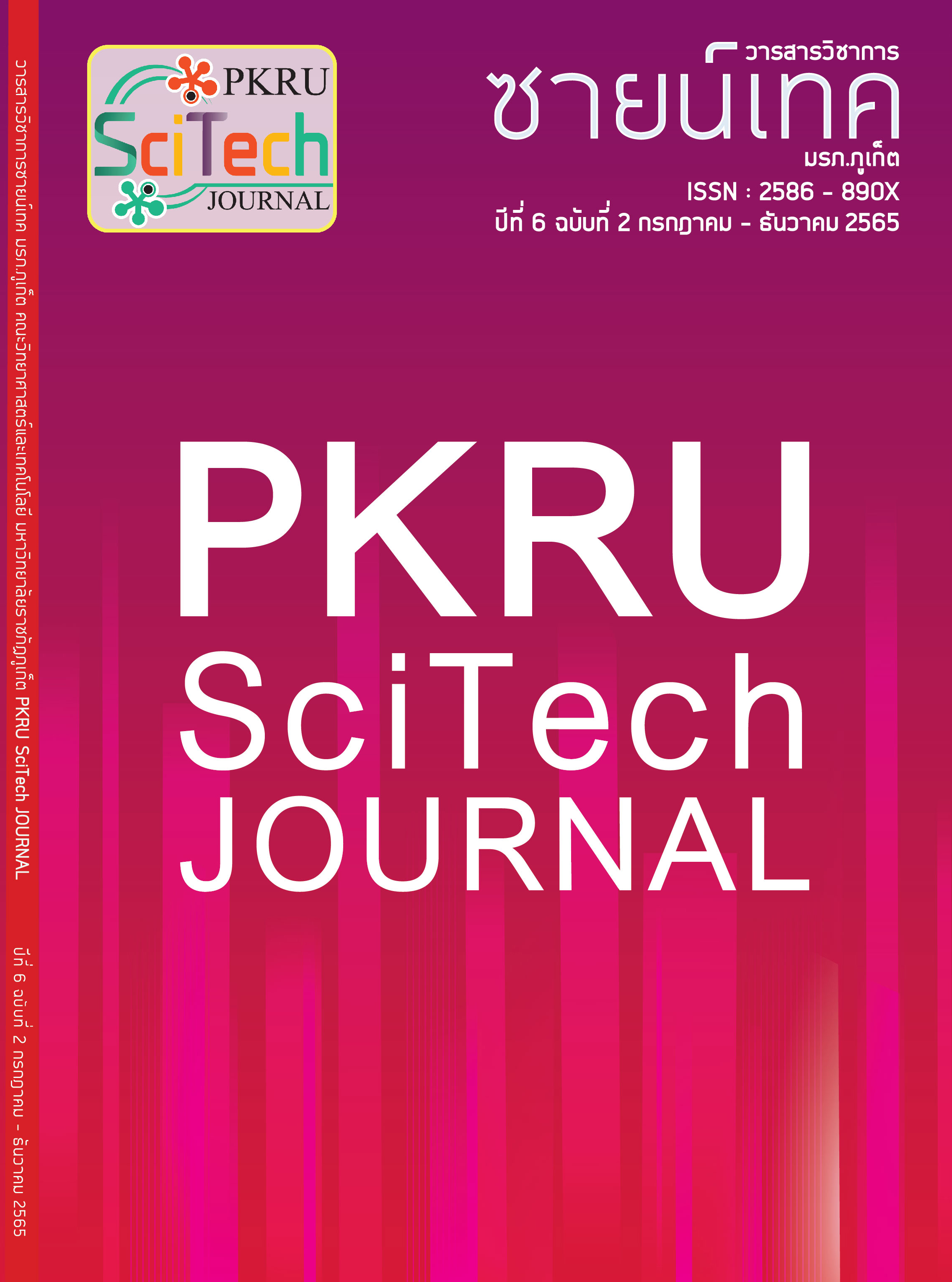The The Effect of Pasteurization on the Quality and Shelf Life of Ready to Eat Southern Sour Curry
Main Article Content
Abstract
This research studied the pasteurization temperature (70, 80 and 90°C) and time (3, 5 and 7 min) on qualities of ready to eat Southern sour curry in laminated pouch. The results showed that the increasing of temperature and time resulted in the decreasing of L* (lightness) in curry products however their a* (redness) and b* (yellowness) were increased. The texture analysis of seabass in curry products showed that the increasing of pasteurization temperature resulted in the decreasing of their hardness, gumminess and chewiness (P<0.05). The analysis of chemical composition showed that lipid, protein, carbohydrate, fiber and ash in those products were significant different (P<005). However, there was no relation between pasteurization process and chemical composition. The microbiological evaluation showed that food pathogens were not found in curry products pasteurized at 80-90°C. Furthermore, the sensory evaluation of Southern sour curry in laminated pouch pasteurized at 80°C for 3 min showed that product was accepted by assessors with the mean scores was in the range of moderately like to very much like. For the evaluation of shelf life, pasteurized Southern sour curry in laminated pouch which kept at 4°C, was prolonged for 18 days, whereas the storage at room temperature was extended its shelf life for only 9 days. Therefore, this product could be supported for the commercialization.
Article Details

This work is licensed under a Creative Commons Attribution-NonCommercial-NoDerivatives 4.0 International License.
- The original content that appears in this journal is the responsibility of the author excluding any typographical errors.
- The copyright of manuscripts that published in PKRU SciTech Journal is owned by PKRU SciTech Journal.
References
ทิพวัลย์ รามรง และชัยรัตน์ วงศ์กิจรุ่งเรือง. (2021). ศักยภาพอาหารท้องถิ่นในการส่งเสริมการ ท่องเที่ยวผ่านอาหารท้องถิ่น. วารสารสังคมศาสตร์และมนุษยศาสตร์, 47(2), 59-74.
Chanchaichaovivat, A., Kirdtabtim, S., & Phornphisutthimas, S. (2019). Standards for community food products. Journal of research unit on science, technology and environment for learning, 10(1), 137-149.
Barron, F. H., Fraser, A. M., & Innocenzo, M. (2012). Acidified foods: food safety considerations for food processors. Food industry, 231-239.
Peng, J., Tang, J., Barrett, D. M., Sablani, S. S., Anderson, N., & Powers, J. R. (2017). Thermal pasteurization of ready-to-eat foods and vegetables: Critical factors for process design and effects on quality. Critical reviews in food science and nutrition, 57(14), 2970-2995.
U.S. Department of Health and Human Services. (2019). Grade “A” Pasteurized Milk Ordinance. [Online], retrieved from https://www.fda.gov/media/140394/download (10 August 2022).
Ifesan, B. O. T., Siripongvutikorn, S., Thummaratwasik, P., & Kanthachote, D. (2010). Stability of antibacterial property of Thai Green curry during chilled storage. Journal of Food Processing and Preservation, 34, 308-321.
Nor, S. M., & Jirarat, A. (2015). Effects of pasteurization at different temperature and time on marinated shrimp in green curry. Malaysian Journal of Analytical Sciences, 19(4), 739-744.
กระทรวงสาธารณะสุข. (2563). ประกาศกระทรวงสาธารณสุข (ฉบับที่ 416) พ.ศ. 2563 ออกตามความในพระราชบัญญัติอาหาร พ.ศ. 2522 เรื่อง กำหนดคุณภาพหรือมาตรฐาน หลักเกณฑ์เงื่อนไข และวิธีการในการตรวจวิเคราะห์ของอาหารด้านจุลินทรีย์ที่ทำให้เกิดโรค. [ออนไลน์], สืบค้นจาก http://food.fda.moph.go.th/law/data/announ_moph/P416.PDF (10 สิงหาคม 2565).
ภาสพงศ์ ผิวพอใช้ และจุฬารัตน์ ดวงศรี. (2021). คำศัพท์การประกอบอาหารและวัฒนธรรมการ บริโภคของคนไทย: ศึกษาจากตำรับอาหารของท่านผู้หญิงกลีบ มหิธร. Journal of Roi Kaensarn Academi, 6(9), 35-49.
Dominguez-Hernandez, E., Salaseviciene, A., & Ertbjerg, P. (2018). Low-temperature long-time cooking of meat: Eating quality and underlying mechanisms. Meat Science, 143, 104-113.
Bland, J., Bett-Garber, K. L., Li, C. H., Brashear, S. S., Lea, J. M., & Bechtel, P. J. (2018). Comparison of sensory and instrumental methods for the analysis of texture of cooked individually quick frozen and fresh-frozen catfish fillets. Food Science & Nutrition, 6(6), 1692-1705.
AOAC. (2016). Official methods of analysis of AOAC International (20th edition). USA: AOAC international.
BAM. (2022). Bacteriological Analytical Manual (BAM). [online], retrieved from https://www.fda.gov/food/laboratory-methods-food/bam-chapter-5-salmonella (5 April 2022).
Yang, J., & Lee, J. (2018). Korean consumers’ acceptability of commercial food products and usage of the 9‐point hedonic scale. Journal of Sensory Studies, 33(6), e12467.
กระทรวงสาธารณสุข. (2556). ประกาศกระทรวงสาธารณสุข (ฉบับที่ 355) พ.ศ. 2556
เรื่อง อาหารในภาชนะบรรจุที่ปิดสนิท. [ออนไลน์], สืบค้นจาก http://food.fda.moph.go.th/law/data/announ_moph/P355.pdf (10 สิงหาคม 2565).
Prathapan, A., Lukhman, M., Arumughan, C., Sundaresan, A., & Raghu, K. G. (2009). Effect of heat treatment on curcuminoid, colour value and total polyphenols of fresh turmeric rhizome. International journal of food science & technology, 44(7), 1438-1444.
Perva-Uzunalić, A., Škerget, M., Weinreich, B., & Knez, Ž. (2004). Extraction of chili pepper (var. Byedige) with supercritical CO2: effect of pressure and temperature on capsaicinoid and colour extraction efficiency. Food Chemistry, 87(1), 51-58.
Kato, H. C., Lourenço, L. D., Araújo, E. A., Sousa, C. L., Joele, M. R., & Ribeiro, S. D. (2016). Change in physical and chemical characteristics related to the binomial time-temperature used in sous pasteurization see Tambaqui (Colossoma macropomum). Arquivo Brasileiro de Medicina Veterinária e Zootecnia, 68, 224-32.
Igual, M. G. M. E., García-Martínez, E., Camacho, M. M., & Martínez-Navarrete, N. (2010). Effect of thermal treatment and storage on the stability of organic acids and the functional value of grapefruit juice. Food Chemistry, 118(2), 291-299.


